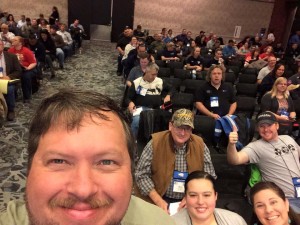In Part 1, we talked about developing your content and polishing your presentation style. In this post, let’s discuss how you sell yourself to conferences.
- Beat the bushes. I can assure you that the world is not going to beat a path to your door. When people ask me how to break onto “the speaking circuit,” the answer is truthfully, “Abandon any sense of dignity, and shamelessly self-promote.” To me, that’s the hardest part of being a conference speaker. It feels vaguely unseemly, but that’s the only way people are ever going to hear you speak. Start local, at your state or regional conferences. Once you get booked to speak somewhere, make it a point to be invited back – even if you did it for free. Scour the Internet, state-by-state, searching for EMS conferences. Bookmark any Calls for Presentations, and cultivate a network of fellow speakers who can alert you to potential speaking opportunities. Get to know the conference committee members at each conference you attend. Deadlines for submissions to spring conferences is usually late summer or early fall of the previous year, and deadlines for fall conferences is usually late spring.
- Get used to rejection. You’re going to get turned down. A lot. Just keep submitting proposals. But when you submit…
- … Be memorable. Think of your presentation title and description as your “elevator sales pitch.” You’re the equivalent of a starving screenwriter trying to pitch your script to a hotshot producer somewhere between the lobby and the twentieth floor, so you need to grab his attention fast, and hold it. Don’t start your description with the stiff, boring, “This presentation will prepare the listener to…” boilerplate. Think of a unique and catchy title to your talk, and put some dash and theatricality into your description. You want to catch the eye of a conference participant who is casually scanning the brochure because the hotshot speaker he wanted to hear had no empty seats in his room. Be catchy enough in that title and description, and then deliver on it, and eventually you’ll be that hotshot speaker whose talks are always standing room only.
- Don’t sell yourself short. While you may be tempted to speak for free just to get your foot in the door – and you may have to do just that – once you’ve broken through that barrier, you need to start charging for your services. How much is up to you. You’re being unrealistic if you think you’re going to start out getting an honorarium of $1000/day, but neither do you want to be known as “the cheap guy.” I raised my daily honorarium 30% a few years back, and I got booked for more conferences than ever. For most large conferences, $500/day is an entirely reasonable starting point, and you’re always free to negotiate down if that price is too rich for a smaller conference.
- Always have proposals at the ready. When you develop a lecture proposal, don’t just type it into the online submission portal as you go. Start a Word document with a standard format. All of mine resemble this:
- Title (something unique)
- Intended audience (BLS, ALS, general, educators, administrators, etc.)
- Length (typically 60-90 minutes)
- Description (bold and theatrical, 100-150 words)
- Objectives (no more than 4 for a 60 minute presentation, 6 for 90 minutes) Include a time frame and method for each objective (eg, “15 minutes, lecture” or “10 minutes, group discussion”), and use action verbs for your learning objectives. Many CE accrediting bodies require specific nomenclature for educational objectives. A good list can be found here.)
- AV and Media requirements (projector, computer sound, wireless microphone, easel, flip charts, etc.)
- Brief speaker bio (something 100 words or less, suitable for printing in a conference brochure)
- Have materials ready. For every presentation you’ve developed, print an electronic pdf of the handouts, that the conference can upload to its website, or print to give to participants as they enter the room. People love handouts. They throw them away 99% of the time, but they still feel cheated if they weren’t available. Develop your curriculum vitae, and update it after every conference. Most conferences have an electronic submission portal that you can simply cut-and-paste your materials into, and many allow you to attach them.
- Show up early, and anticipate complications. I bring my computer to every conference, and I deeply distrust any system that requires me to upload my presentations to a single server. The reason is, when your presentations are rich in embedded multimedia like music and video – as most of mine are – the presentations invariably get borked when transferred from one computer to another. File paths get scrambled, software versions aren’t compatible, whatever. It’s more common that they don’t work properly than it is when they do. So show up early, and be prepared to tweak and troubleshoot before you go on.
- Say goodbye to your social life. Remember when you used to go to EMS conferences and gorge on free food and cheap booze supplied by the vendors, hang out with your colleagues and close down the bar at 3:00 am, then shuffle into a lecture the next day, groggy and bleary-eyed? Yeah, you can’t do that when you’re the one giving the lecture. Oh, you’ll still be up at 3:00 am, but you’ll be tweaking your presentation and ironing your clothes, just like every other glamorous conference speaker you used to admire.
- Be gracious. Say thanks, and mean it. Answer questions and chitchat with attendees, but be courteous and move it outside to let the next speaker set up. Thank the conference volunteers, and make certain you send a note or email thanking the conference organizers for doing such a good job, and for giving you the opportunity to speak. Yes, even if they sucked. Especially if they sucked.
- Don’t give up your day job. You’re not going to get rich, nor will you retire to a life on the speaking circuit. I’d be flabbergasted if you made even half of your yearly EMS salary, even as an frequently-booked speaker. But what you can do, is earn immense satisfaction in becoming a true steward of your profession, and by sharing fellowship with a group of people who are every bit as passionate about the advancement of EMS as you are. EMS conferences don’t do much to pad your bank account, but they do wonders in recharging your career satisfaction batteries.
And really, that’s payment enough.
 Ambulance Driver Files A Day in the Life | Kelly Grayson
Ambulance Driver Files A Day in the Life | Kelly Grayson



